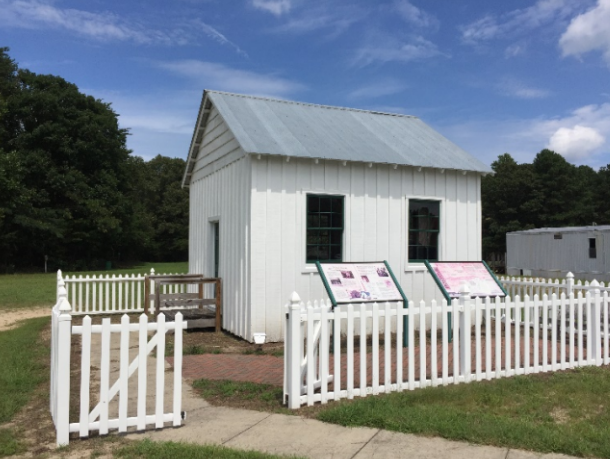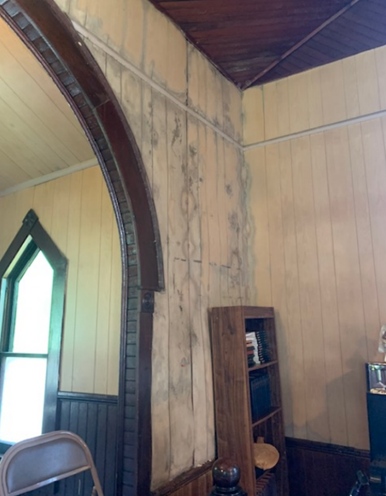By Ivy Weeks, Capital Programs Administrator
We are pleased to announce this year’s African American Heritage Preservation Program (AAHPP) grant recipients! Jointly administered by The Maryland Commission on African American History and Culture and the Maryland Historical Trust, the AAHPP promotes the preservation of Maryland’s African American heritage by funding construction projects at significant sites throughout the state. This year’s projects include museums, cemeteries, an interpretive memorial, a historic lodge, community centers, and a historic school. Read more about our newly funded AAHPP grant projects below.
Mount Auburn Cemetery – Baltimore City ($100,000) | Sponsor: Mount Auburn Cemetery Company
Dedicated in 1872 and originally known as “The City of the Dead for Colored People,” Mount Auburn Cemetery was one of the first—and now only remaining—cemetery owned and operated by African Americans in Baltimore. It is a unique representation of the values and burial traditions of this community from the late 19th century to the present. Grant funds will support repairs to damaged decorative and security fencing, as well as resurfacing inner roadways.
Hoppy Adams House – Annapolis, Anne Arundel County ($100,000) | Sponsor: Charles W. “Hoppy” Adams Jr. Foundation, Inc.
Celebrated African American radio broadcaster for WANN Annapolis, Charles “Hoppy” Adams Jr was widely known for spreading soul and R&B music to Black and white audiences. Adams hosted popular concerts at Carr’s Beach, an important venue on the “Chitlin Circuit” during segregation. This project will rehabilitate the home Adams built for himself in 1964, which was left to the elements when he passed in 2005. Future phases of work will convert the space into a museum and event space to celebrate the life of Hoppy Adams and the unifying effect of R&B music during this divisive era.
Mt. Calvary United Methodist Church – Arnold, Anne Arundel County ($86,000) | Sponsor: Mount Calvary United Methodist Church
Mt. Calvary United Methodist Church began gathering on this site between 1832- 1842, making it the oldest African American congregation in Arnold. Grant funds will support the replacement of the 40-year-old roof and repairing the deteriorating handicap ramp that is currently causing moisture intrusion for the church, as well as adding a second ramp.
Eastport Elementary School, 3rd Street – Annapolis, Anne Arundel County ($100,000) | Sponsor: The Seafarers Yacht Club, Inc.
Originally built in 1918 as Eastport’s school for African American children, Eastport Elementary School closed when Anne Arundel School finally integrated, nearly a decade after Brown v Board of Education. Today, the building is owned by the Seafarers Yacht Club, Inc., formed in 1959 by a group of Black men with a shared interest in boating. They purchased the vacant building in 1967 after they were inspired to form their own club in response to marinas that routinely refused Black boaters to dock at their piers, as well as yacht clubs that denied membership to Black captains. This grant project will fund interior and exterior repairs and security improvements.

Old Wallville School – Prince Frederick, Calvert County ($27,000) | Sponsor: Friends of the Old Wallville School, Inc.
A representation of the segregated educational facilities of the late 19th and early 20th centuries, the Old Wallville School is a one-room wooden schoolhouse that was used to educate African American students in the unincorporated village from 1880-1934. In 2006, the building was moved and placed adjacent to Calvert Elementary School. Now restored to its appearance in the early 1930s, it is used as a popular heritage tourism destination. This grant project will fund rot and roof repairs, structural signage replacement, and painting to protect the building from the elements and heavy use.
Parren J Mitchell House and Cultural Center – Baltimore City ($100,000) | Sponsor: Upton Planning Committee, Inc.
Originally built 1880, this rowhome is probably best known for its resident Parren Mitchell, the Black Congressmen to represent Maryland. This renovation project will return the long-vacant building to its historic role as a center of political and social life for the community and region as the new Parren Mitchell Center, which will serve as an events and retreat center. Grant funds will support exterior masonry restoration and repointing, window restoration, and accessibility improvements.
Boyds Negro School – Boyds, Montgomery County ($50,000) | Sponsor: Boyds Clarksburg Historical Society, Inc.
Built in 1895, Boyds Negro School is Montgomery County’s only remaining one-room schoolhouse for African American children that is regularly open to the public. This project will focus on engineering and site work to protect the building and grounds from flooding. It will also add a handicap ramp to make the building ADA accessible.
Richard Potter House – Denton, Caroline County ($50,000) | Sponsor: Fiber Arts Center of the Eastern Shore Inc.
Richard Potter published a book in 1866 – The Narrative of the Experience, Adventures and Escape of Richard Potter – documenting his experiences from when he was kidnapped in Greensboro, Maryland, enslaved in Delaware, and eventual escape and return to Caroline County to what is now known as the Richard Potter House (c.1810). The site is included as part of the National Park Service’s Network to Freedom. This project will restore the first floor of the home to its 1855 interior, using it as a museum and classroom space.
Mt. Zion Memorial Church– Princess Anne, Somerset County ($86,000) | Sponsor: Somerset County Historical Trust, Inc.
Mt. Zion Memorial Church survives as one of the few late-19th century African American churches in Somerset County and its intact condition enhances its architectural significance. Inside, one of the most distinctive features of the building — the early-20th century bead board ceiling – is at risk due to a leaking roof. While Mt. Zion is no longer used to hold regular church services, it does reflect the lasting influence of Methodism on the African American community in Somerset County. Grant funds will repair severe water damage.
New Bethel Methodist Episcopal Church – Berlin, Worcester County ($67,000) | Sponsor: New Bethel United Methodist Church, Inc.
Founded in 1855, New Bethel is the oldest African American Methodist congregation in Worcester County. Known as the Godfather of gospel music, Rev. Charles Albert Tindley was a member of the church in boyhood, and attended when he would visit from Philadelphia as an adult. The grant project will fund roof replacement and carpentry repairs.
Ridgley Methodist Church – Landover, Prince George’s County ($50,000) | Sponsor: Mildred Ridgley Gray Charitable Trust, Inc.
Built in 1921, the Ridgley Methodist Episcopal Church is in its original form and features memorial stained-glass windows with pointed frames. The building was relocated by the State Highway Commission in 1990. The cemetery, which dates to 1892, occupies the west end of the property. There are a number of unmarked graves, and about 20 gravestones dating from the 1910s to the 1940s. Most of the stones are hand-carved and many feature a carved flower and vine motif. The grant project will fund exterior repairs to the church and conservation of the cemetery.
Information in this section has been updated since publication.
St. James African Union First Colored Methodist Protestant Church – Towson, Baltimore County ($30,000) | Sponsor: St. James African Union Methodist Protestant Church, Inc
In 1881, the St. James African Union First Colored Methodist Protestant Church was built on property believed to be the first documented African American landholding in Towson. The church began as a one-story wood-frame building and was raised to two stories in 1906 to accommodate the congregation’s growth. This project will fund structural repairs to the roof framing and chimney, as well as full roof replacement.
Buffalo Soldier Park – Eden, Wicomico County ($74,000) | Sponsor: Greater Washington Dc Chapter Of The Ninth And Tenth (Horse) Cavalry Association, Inc.
Named “Buffalo Soldier House” for his time in the United States 9th Cavalry Regiment Company C, Thomas Polk, Sr. built a two-story home on his property sometime in the late 1920s and rebuilt it in 1962-63 after it was destroyed in a fire. This project will focus on the pre-development and renovations needed to convert his home into the Buffalo Soldier Living History Site, which will include a visitors’ center and exhibit space.
Adams Methodist Episcopal Church and Cemetery – Lothian, Anne Arundel County ($80,000) | Sponsor: Adams U.M. Church
Adams Methodist Episcopal Church site contains two church buildings: the original 1883 church, a simple weatherboard-sided late-Victorian structure; and a more modern brick church, completed in 1968. Work for this project will focus on the brick church and on the graveyard on site.
If you are planning to apply for funding for an AAHPP project, the FY2024 grant round will begin in the spring of 2023, with workshops in April and applications due July 1. For more information about AAHPP, please visit our website or contact Ivy Weeks, Capital Programs Administrator, at ivy.weeks@maryland.gov.
























 The new system allows both in-house and remote access to the documentation of over 60,000 architectural and archeological resources in a variety of ways. Consultants and staff can view a proposed project area and see all known cultural resources, with links to Maryland Inventory of Historic Properties forms, National Register nominations, determinations of eligibility, and other detailed documents. Map-based Medusa also allows you to look up a property by name, address or inventory number, and view that property on a map along with associated forms and photos.
The new system allows both in-house and remote access to the documentation of over 60,000 architectural and archeological resources in a variety of ways. Consultants and staff can view a proposed project area and see all known cultural resources, with links to Maryland Inventory of Historic Properties forms, National Register nominations, determinations of eligibility, and other detailed documents. Map-based Medusa also allows you to look up a property by name, address or inventory number, and view that property on a map along with associated forms and photos.

